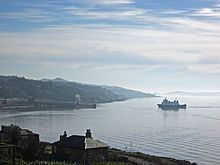OS grid reference NS195695 Sovereign state United Kingdom Local time Monday 4:21 AM | Post town WEMYSS BAY Dialling code 01475 | |
 | ||
Weather 7°C, Wind W at 19 km/h, 84% Humidity | ||
Wemyss Bay /ˌwiːmz ˈbeɪ/ is a village on the coast of the Firth of Clyde in Inverclyde in the west central Lowlands of Scotland. It is in the traditional county of Renfrewshire. It is adjacent to Skelmorlie, North Ayrshire. The villages have always been in separate counties, divided by the Kelly Burn.
Contents
- Map of Wemyss Bay UK
- Etymology
- History
- Kelly Estate
- Other notable buildings
- Sport and recreation
- References
Map of Wemyss Bay, UK
Wemyss Bay is the port for ferries to Rothesay on the Isle of Bute. Passengers from the island can connect to Glasgow by trains, which terminate in the village at the remarkable Wemyss Bay railway station, noted for its architectural qualities and regarded as one of Scotland's finest railway buildings. The port is very exposed, so in high winds the ferries must travel up river to Gourock to dock.
Etymology
The name Wemyss is derived from the Scottish Gaelic uaimh which means cave. It is believed to be taken from the caves of the Firth of Forth where the Clan Wemyss made their home. The chiefs are one of the few noble families who are descended from the Celtic nobility through the Clan MacDuff Earls of Fife.
The name Wemyss Bay may be associated with Bob Wemyss, who was the owner of a hut on the shore in the 19th century.
History
Wemyss Bay was created in the early 19th century as a 'marine village' and watering-place by Robert Wallace of Kelly, whose lands were adjacent to the bay. Wallace became Greenock's first MP and was instrumental in establishing the penny post. London merchant James Alexander further developed the area by constructing the first steamboat pier, which was swept away by a hurricane in 1856. Its successor suffered a similar fate and was replaced by the current railway terminus and pier.
The opening of the railway connection in 1865 brought even grander houses. Among the village's notable residents included Sir George Burns, who with Samuel Cunard founded the British and North American Royal Mail Steam Packet Company (later the Cunard Line), and his son John (later 1st Baron Inverclyde) who lived at Castle Wemyss, which stood on Wemyss Point above the bay itself. Alan, 4th Baron Inverclyde was briefly married to the actress June, who was one of Alfred Hitchcock's earliest leading ladies in the 1927 film The Lodger: A Story of the London Fog.
Kelly Estate
The inventor of paraffin (kerosene) and industrial magnate James "Paraffin" Young had a house at Kelly, and was buried in the old Inverkip churchyard. David Livingstone was a friend of Young and a replica of a hut the explorer occupied near Victoria Falls was built in the grounds of Kelly as a memorial to Livingstone. Kelly House was rebuilt twice, the first structure dating from the 15th century, being destroyed by fire in 1740, the second, a William Leiper building, dating from 1793 and the third and final house also destroyed in a fire in 1913, only having been built in 1890. Blame was laid at the suffragettes but no evidence was ever found. Kelly remained a burnt out ruin for several years. A caravan park now occupies the estate.
Other notable buildings
A memorial on the shore road recalls 'The Gaiter Club', whose members included Anthony Trollope, Lord Kelvin, Lord Palmerston and the Earl of Shaftesbury.
Neither Castle Wemyss nor James Salmon's Wemyss House remain, having been demolished in the 1980s and 1940s respectively. Also gone is J.J. Burnet's episcopal Inverclyde Church, which stood on the shore road of Undercliff Road and was demolished in 1970.
The Castle Wemyss estate and adjoining areas had been sold off in the 1960s to property developers and since then the village has grown considerably, albeit largely a dormitory settlement for Greenock and Glasgow. However several of the fine red sandstone properties remain and are now seen as renovation opportunities. There is a butcher, newsagent, cafe and fish and chip shop in the village and a pub and cafe in the extensive railway station buildings. Parking your vehicle could be a bit difficult though, as it is a really tight space on the main road through, if you get a space at all. The railway station does have parking at about £3.00 a day.
Sport and recreation
Wemyss Bay is host to the Ardgowan Youth Development football program run by parents in the area to fill the role of a local boys team. The team train at the Wemyss Bay Primary astro turf pitch twice a week, to join, parents and prospective players are expected to talk to one of the coaches if they or their child are interested in joining.
